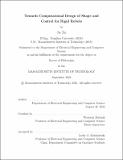Towards Computational Design of Shape and Control for Rigid Robots
Author(s)
Xu, Jie
DownloadThesis PDF (39.15Mb)
Advisor
Matusik, Wojciech
Terms of use
Metadata
Show full item recordAbstract
Designing a performing robotic system for given tasks is traditionally labor-intensive for finding the optimal configurations of its hardware shape and/or software controller. The underlying coupling of the hardware shape and the software control of a robot results in an enormous parameter space involving both discrete parameters (i.e., topology structure of the robot) and continuous parameters (i.e., morphological dimensions of each robot link, the control parameters), optimizing which traditionally requires significant amounts of expert knowledge from roboticists and many manual design iterations. Intending to automate the robot design process, computational robot design has attracted increasing attention from robotics, graphs, and artificial intelligence researchers. However, building a general computational robot design process is extremely hard due to several challenging problems, including but not limited to representation, performance evaluation, and optimization problems. This thesis identifies some key challenges in the computational robot design pipeline and proposes our corresponding solutions. We first take the manipulator design as an example to present our robot design representations for both discrete and continuous robot shape parameters. With the proposed robot representations, we then explore the corresponding robot optimization techniques. In this part, we first introduce how we leverage differentiable simulators to efficiently optimize the robot control policy with the robot configuration fixed. Next, we delve into the more complicated co- design problems requiring optimization of both the shape and control of a robot. We present two novel algorithms for optimizing discrete shape parameters and continuous shape parameters, respectively. Finally, we step further toward the more realistic multi-objective robot design problems and present our solutions for finding a set of Pareto-optimal robot designs trading off multiple different objectives and tasks. We conclude this thesis by envisioning an ultimate computational design pipeline and discussing open research directions toward this ultimate goal.
Date issued
2022-09Department
Massachusetts Institute of Technology. Department of Electrical Engineering and Computer SciencePublisher
Massachusetts Institute of Technology